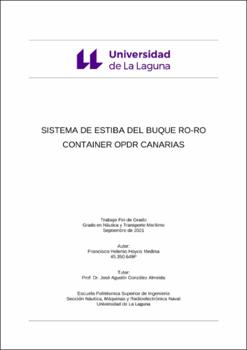Sistema de estiba del buque ro-ro container opdr Canarias
Date
2021Abstract
En el siguiente trabajo se muestra los conocimientos adquiridos a lo largo del
embarque para la consecución del título de piloto y como finalización de los estudios de Grado
en Náutica y Transporte Marítimo. Profundizaremos en el sistema de estiba en un buque de
clase RO-RO CONTAINER, específicamente, el buque OPDR CANARIAS, de la naviera
Berhand Schulte, donde he realizado la mayoría de mis prácticas profesionales, en una línea
regular que establece la conexión entre la Península Ibérica y las Islas Canarias.
En este trabajo analizaremos en profundidad la metodología de estiba de
contenedores y carga rodada de dicho barco, como debemos realizar los planos de carga con
referencia a los diferentes puertos de destino, carga de mercancía rodada, frigorífica y sobre
todo las dificultades que nos podemos encontrar a la hora de la estiba mercancía peligrosas
y todas las reglas que debemos de acatar a la hora de su embarque.
En el desarrollo de este documento se podrá observar diversos documentos e
imágenes de elaboración propia, que nos facilitará el trabajo y análisis de todo el proceso de
carga y descarga.
Por otro lado, profundizaremos en el programa PAL, que tiene como objetivo principal
la disminución de trámites burocráticos, que están sometidas la gran mayoría de empresas
marítimas del mundo, así como toda la documentación necesaria para realizar todas las
operaciones que nos conciernen.
Antes de meter todos nuestros datos en el programa PAL, hemos de trabajar en
nuestro programa llamado EASECON, el cual, es un programa de carga que nos servirá de
ayuda para todas nuestras operativas. En este trabajo nos adentraremos en el EASECON,
tanto en su función, como el modo que ha de trabajar en él. The following assignment outlines the knowledge acquired throughout the shipment in
order to attain the title of pilot and to end the studies of nautical and maritime transport grade.
We will look in depth at the stowage system of a vessel of RO-RO CONTAINER class,
specifically the vessel OPDR CANARIAS, belonging to the shipping company Berthand
Schulte, where I have worked in a professional capacity on a regular route which maintains
the connection between mainland Spain and the Canary Islands.
This project meticulously analyses the method of stowage containers and ro-ro of the
afore mentioned vessel, as we must adhere to the loading blueprints with reference to the
different destination ports, load of rolled merchandise, refrigerator and above all, the difficulties
found occasionally at the time of stowage, dangerous merchandise and all the necessary
regulations at the time of shipment.
As a result of this document one will be able to observe various other documents and
images from my own findings which will help the work and the analysis of the entire loading
and unloading process.
Additionally, we will study at length the PAL program whose main target is to decrease
bureaucracy that the vast majority of maritime businesses are encountering. Thus, all the
documentation needed to make all the operations must concur.
Before we input all the data into the PAL program, EASECON, which is a loading
program, needs to be used which will help with all our operations. In this assigment we fully
detail the EASECON program; not only its function but the way in which it needs to be
implemented.





